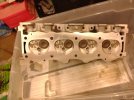So this concerns my green 1999 p38 with 4l V8. It has been sat for 8 years before I acquired it.
I just did some major service work and found a considerable amount of milk in de oil filler cap. Also tiny tiny bit in the drained oil. After changing oil and running the engine visible condensation droplets in oil filler cap. Coolant level is low (only just in the expansion tank), but the drain plug was leaking a bit. No signs of oil in the coolant (eg. milk, black line in reservoir, black traces in coolant).
At first it seems to me that I have a coolant-oil gallery head gasket leak. However I find it strange that the contamination is only in one direction (coolant towards oil).
I don't know how what the heads look like on this engine. Is it possible to have an oil-coolant gallery leak on these or are they not adjacent?
Any other places where coolant could leak into the oil.?
On this type of leak I would expect to at least see some evident in the coolant expansion tank. From a sitting vehicle I expect some condensation in the engine but the amount of milk under the filler cap seems to be too much to be condensation related
I don't really care to do the work, and the parts don't seem too expensive at first glance, but of course if it doesn't need to be done it doesn't need to be done.
Any advice will be appreciated! Also ways to test the gaskets (except for compression test which i will do tomorrow)?

